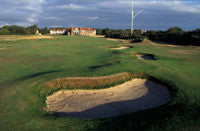Keeping the Environmental Agency happy
Keeping the Environment Agency happy
By Maureen Keepin
Water-wise at Royal Lytham and St Anne's.
Effective and efficient irrigation is vital with increasing pressure to conserve water being put on golf clubs by the Environment Agency. First opened in 1886, the Royal Lytham and St Anne's Golf Club had a new high-tech irrigation system installed to greens, approaches, fairways and tees, by leading drainage and irrigation specialists M J Abbott. 
This replaced an out-dated system put in during the '60s. "Financial savings, environmental considerations and the benefits to turf grass health were the primary reasons for undertaking this project," says Paul Smith, Head Greenkeeper. "Our system was more than 25 years old and the main infrastructure of pipes was struggling to cope with ever-increasing demands."
Designed by Wardle Consulting Engineers, it was vital disruption was kept to a minimum. Comprehensive system Precipitation and uniformity are key aspects which need to be addressed to achieve the most efficient irrigation system. The contractors laid more than 25 kilometres of underground pipe and cable to service 850 pop up sprinklers. A Rainbird Nimbus 2 central controller is the powerhouse of the operation, and is linked to a weather station - MWS10 - which provides information on the evapotranspiration rates (ET) but does not download, so there is a manual change of programmes.
The system can calculate the ET and provide accurately the amount of water needed, so water resources are managed efficiently and not wasted. "With three separate supplies of water - a small groundwater fed reservoir, a series of shallow boreholes and a mains supply which acts as a back-up, we used some quite complex equipment," says Nigel Wyatt, the contracts director.
Unlike many irrigation systems in the UK, which have full-circle sprinklers on the fairways, the system on the Championship course at Royal Lytham and St Anne's has been designed to be more efficient. To save water, a series of part-circle sprinklers were put in on the fairways and on the outer edges, throwing inwards, so water is not put into the semi-rough and rough. Wider fairways have a triple-row sprinkler system with full-circle sprinklers in the middle row and part-circle sprinklers on the fairway perimeters. The option is retained to set the sprinklers for full-circle operation to irrigate the roughs as well if required.
Such systems consume much less water than conventional full-circle systems and therefore are more environmentally sustainable. Just as importantly it gives the Greenkeeper the option to target water to the desired areas - rather than just blanket irrigation coverage. To minimise damage to the course, cables were installed using a non-tension vibratory mole plough.
Work in all fine turf areas was undertaken off boards, to mitigate problems of tyres marking the turf. "It is vital you manage water very, very carefully," says Paul, Smith, Head Greenkeeper, "and this irrigation system helps us to achieve this."
For further information contact Nigel Wyatt on 01722 716361 or email: nigel.wyatt@mjabbott.co.uk
